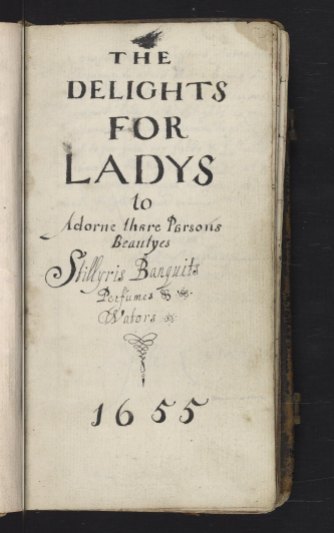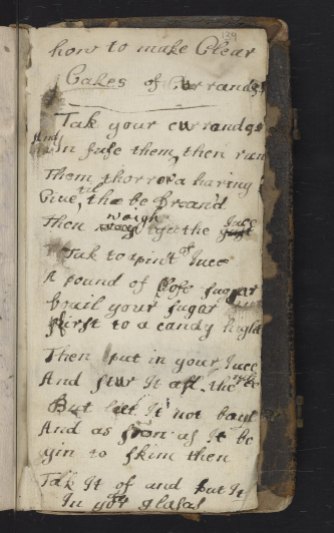Today’s Cooking in the Archives post is also published on ABO-Public: An Interactive Forum for Women in the Arts, 1640-1840. Check out a slightly longer version of this post here.
What do ladies bake? Ladies bake macaroons, tasty almond macaroons.
This recipe “To make maccarons of valentia Almonds” is from MS Codex 627 The delights for ladys: to adorne there persons beautyes stillyris banquits perfumes & wators. MS Codex 627 is designed to look like a printed book and includes a title page with the date 1655, a full table of contents, and a running header “The delights” on the verso and “for ladies” on the recto of on each opening. We’ve only worked with one other manuscript with these features in this project to date: MS Codex 625 where we found “Shrewsbury Cakes.”
Another important feature of this manuscript is obscured, rather than revealed, by our digital images: its size. It’s very small! It fits in the palm of your hand. It could be easily carried in a pocket. As such, it may have also been somewhat difficult to use in the kitchen. Many of the other manuscripts we’ve surveyed have been substantially larger and would be easier to prop open on a table for kitchen use.
Although this manuscript is specifically designed as a book for women, it was likely written by a man. After all, the volume is modeled on Hugh Plat’s Delightes for Ladies (1602) which you can read about in more detail here. The introductory letter, partially missing from the manuscript, is signed by a Jose: Lovett and the hand is consistent throughout. This led the Penn cataloger to suggest that this may be Lovett’s book and written in his hand. However, the back of this book contains a reverse recipe book in a few hands signed “Mabella Powell Her Booke.”
Regardless of who wrote the bulk of this book, Mabella Powell was an owner, composer, and reader of its recipes.
The Recipe
To make maccarons
of valentia AlmondsTake one pound of blanched al-
monds and beat them in a marble
mortor with a woden pestill and in
beating of them now and then
about 12 times drop into them
a sponfull of red Rose water and
and when thay are small beaten
put into them one li [pound] of fine suger
well beaten & searsed then take
one grane of muske and a little
amber greece or siuet and dissolue
it in a little Red rose water
and mingled well a mongst it
then take up your past into a faire
Silu[er] or pewter dish and spread
it with a spoone all ouer the
dish and set it in an ouen—
when your bread is new drawne &
when it dryes and begines to looke
white upon the topp then stirr it
& spread it againe and soe use it halfe
a dozen times and within one halfe
quarter of an howre it will bee drye
enough then take the whits of halfe
a dozen new layd eggs and straine
them through a fine Cloth and beat
them alittle and then mingle them
with the almonds & suger & soe
with a little slice lay them upon
a sheete of pure whit papor & set
them in the ouen, the ouen being
then in the sme temper it was in
when bread was newly drawne out
of it, and lay under them for feare
of borning some plate or some such
thing and soe bake them and keepe
them for your use in some cobbord
or some box not farr from the
fire.
This is a fairly simple recipe and the method for cooking it is explained in great detail. It’s rare to see such specific instructions for the oven heat or cookie storage. Beyond halving the quantity I made very few changes.
Our Recipe
1 1/3 C ground almonds (1/2 lb)
rosewater (1-2 T total)
2 T butter
1/2 C sugar
3 egg whites, lightly beaten
Preheat oven to 350 F.Mix ground almonds with 6 drops rosewater stirring the mix after each drop (approximately 1T total.) Melt butter with a drop of rosewater. Stir aromatic butter into the ground almonds mix. Stir in sugar.
Spread the mixture on a baking sheet and bake for 10 minutes. Check at 5 minutes and stir to ensure the edges do not burn.
Return the fragrant, toasted almond mix to a mixing bowl. Stir in 3 lightly beaten egg whites. A sticky dough should form. Line a baking sheet with parchment paper. Use a 1 tsp spoon to scoop this sticky mix onto your baking sheet.
Bake for 15-20 minutes or until the bottom of a macaroon is brown and the top is beginning to brown slightly. Allow to cool for 5-10 minutes before eating. Although they will smell incredibly tempting.
Ladies (and gentlemen) these macaroons are delicious. They are fragrant and nutty. When I served them at a holiday party, my guests simply devoured them. But they are just as nice to eat in a more solitary manner with a nice cup of tea.
Since I used store-bought ground almonds, I imagine my mix was much less oily than it would be if ground from fresh almonds. I added 2T of butter to restore that oil and compensate for not using greasy ambergris, suet, or musk as suggested. The recipe talks about slicing, but there was no way I could slice my sticky cookie mix.
While I think that toasting the almond mix deepened the flavor, I think you could skip that step if you were in a hurry or concerned about burning the mix. However, I think either baking parchment or very well-greased pan is essential to getting these cookies onto a plate in one piece.
Try them with whole almonds or ground, with orange blossom water or other spices.














Reblogged this on First Night History.
Reblogged this on Raine's Recipes.
Pingback: To make maccarons of valentia Almonds: a guest post by Cooking in the Archives collaborators Marissa Nicosia and Alyssa Connell |
Pingback: Restaurando y actualizando recetas de los siglos XVII y XVIII
Pingback: Delicious Historical Recipes Come Back To Life Thanks To Two Scholars - Interesting Videos
Pingback: Delicious Historical Recipes Come Back To Life Thanks To Two Scholars | Know everything
Pingback: Delicious Historical Recipes Come Back To Life Thanks To Two Scholars | New Happiness
Pingback: Las recetas del siglo XVII, reinventadas en tiempos de YouTube – Animal Gourmet
Pingback: Bangkok Globe | Delicious Historical Recipes Come Back To Life Thanks To Two Scholars - Bangkok Globe
I believe that is allow to COOL 5-10 min. before eating.
Sound delicious.
Pingback: Delicious Historical Recipes Come Back To Life Thanks To Two Scholars | Traffic Nova
Pingback: Cooking in the Archives: Updating Early Modern Recipes (1600-1800) in a Modern Kitchen | La Cocina Histórica
Pingback: Like swallowes – marginal notes
Pingback: Recreating lemon biskeats | Before Newton
Pingback: Around the Table: Events – The Recipes Project